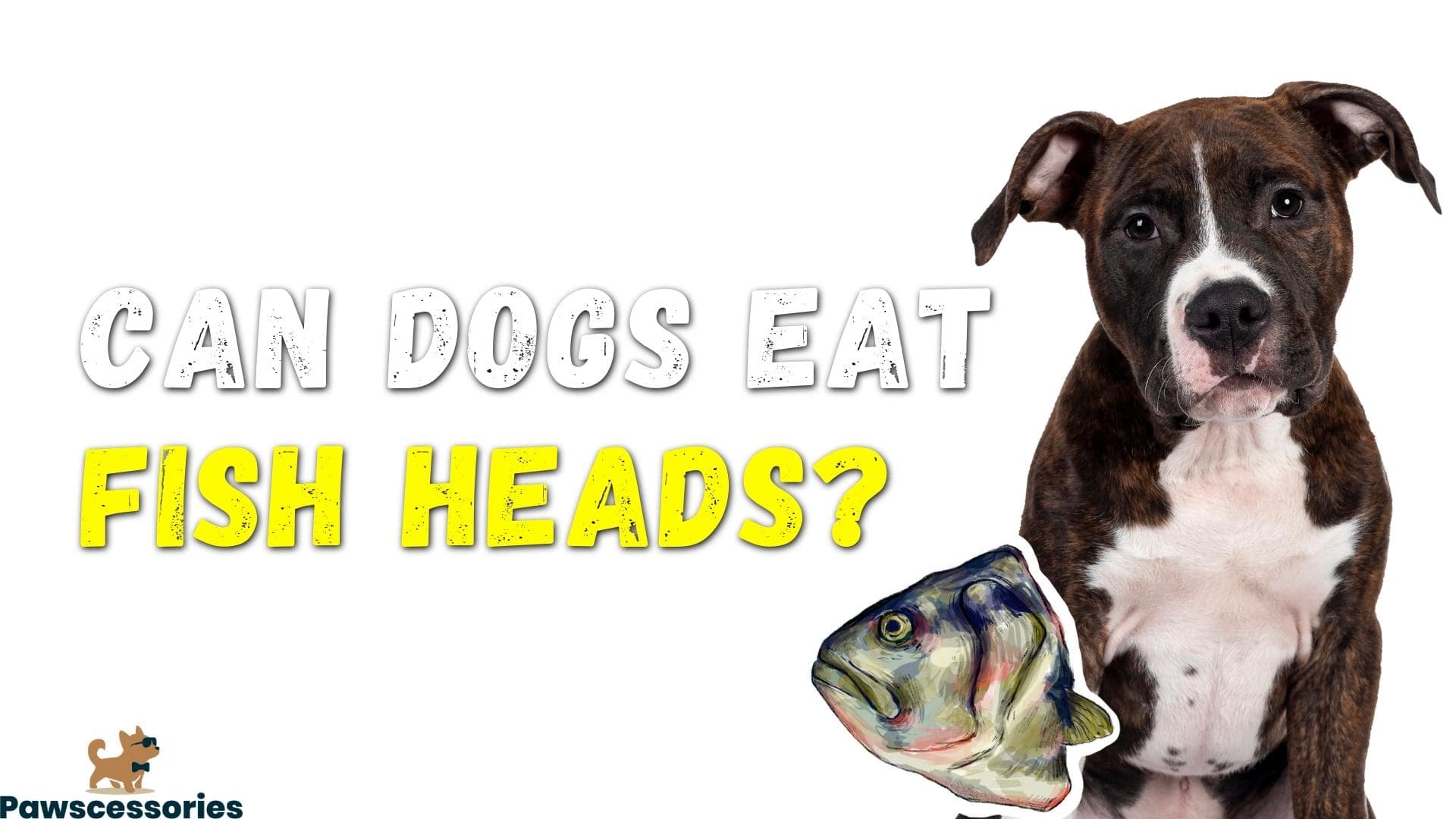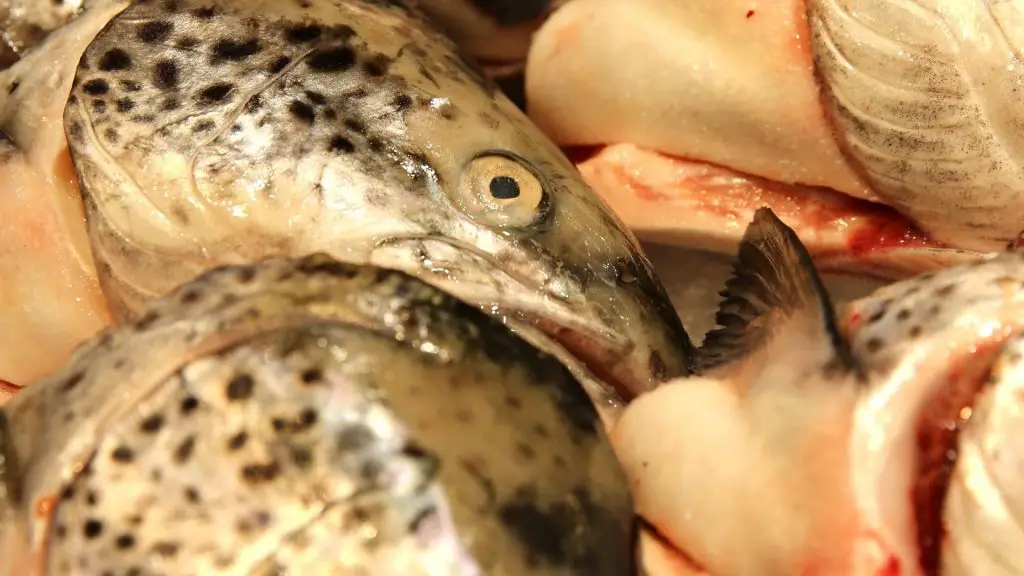Pawscessories is reader-supported. When you buy via links on our site, we may earn an affiliate commission at no cost to you.
Learn more.
Like most dog owners, you probably think of fish as a healthy treat or food for your pup.
After all, it’s packed with protein and omega-three fatty acids, which are great for their coat and skin.
However, you may be wondering if fish heads are safe for dogs to eat.
We’ll to find out we asked a few vets and experts on dog nutrition to find out.
So, can dogs eat fish heads?
Yes, fish heads are generally safe for dogs to eat in moderation. However, fish heads should be frozen to rid them of parasites and harmful bacteria. In addition, the type of fish and the amount you’re feeding your dog also matters. There are some risks associated with feeding certain fish to dogs.
In this article, you’ll discover:
- What fish heads are good or bad for dogs
- The dangers & benefits associated with dogs eating fish heads
- What to do if your dog eats a fresh raw fish head
Let’s dive in.
Table of Contents

Can Dogs Eat Fish Heads?
“Fish heads are actually safe for dogs to eat,” says veterinarian Dr. Jennifer Coates.
“They’re a good source of nutrients like omega-three fatty acids, protein, and minerals like phosphorus.”
However, there are a few things you should keep in mind before feeding your dog fish heads.
First of all, fish heads can contain toxins like mercury and lead, which can be harmful to your dog’s health if consumed in large quantities.
In addition, you also should be mindful of the kind of fish you choose to feed your dog.
Certain species of fish that are slow-growing tend to have higher levels of mercury, lead, parasites, and sturdier bones.
In contrast, faster-growing fish have much softer bones and contain less harmful metals.
Some examples of ideal fish heads to feed your dog include salmon, arctic char, sardines, flounder, walleye, and herring.
Lastly, your dog’s size, age, and stomach do play a role in whether or not you should be feeding fish heads to them.
How To Determine If A Fish Head Is Safe For Your Dog
In order to determine whether or not your dog should be eating a fish head comes down to a few factors.
- Your dog’s size, age, and stomach
- Whether they have eaten fish before or not
- The type of fish
If your dog has never eaten fish before, it’s probably best not to give them a fish head.
Just make sure to slowly introduce fish into their diet if you are considering it. A small piece is unlikely to harm them; just remember to start with a small amount and work your way up.
If your dog is small, make sure to cut up the fish head into smaller pieces. Too much fish can cause problems, so making sure you are giving your dog the appropriate amount is crucial to their wellbeing.
When determining if a fish is okay for your dog to eat, here are some things to consider:
- Select fish with short lifespans that grow fast. They have softer bones and fewer metallic components in their body.
- Smaller fish species of fish are usually better. Look for ones with a lower likelihood of carrying parasites or high levels of mercury.
Here are some common fish species that are used in commercial dog food:
- Salmon
- Whitefish
- Cod
- Whiting
- Walleye
- Flounder
- Arctic char
- Herring
Here are some fish heads you should avoid feeding to your dog:
- Shark
- King mackerel
- Tuna
- Swordfish
- Orange roughy
- And any farm-raised fish
These fish are all considered “slow-growing” fish. Meaning their bones are harder, and they usually have higher levels of mercury.
They also have a higher chance of carrying dangerous parasites.
Furthermore, the reason we recommend staying away from farm-raised fish heads is because of the toxins, antibiotics, and dyes that could be in these fish.
If you’re unsure whether a fish is safe for your dog or not, I recommend avoiding it altogether.

Health Benefits Of Fish Heads For Dogs
Now that you know how to determine which fish heads are safe for dogs to eat let’s take a look at some of the benefits associated with feeding them to your pup.
Fish heads contain a high level of omega-three fatty acids.
Omega-three fatty acids have numerous health benefits for dogs, including:
- Reducing inflammation
- Improving cognitive function
- Lowering cholesterol levels
- Supporting joint health
- Aiding in weight loss
Fish is also a great lean source of protein. It’s the same reason many dog food companies will include fish as the main ingredient.
Protein helps to build and repair muscle tissue, maintain a strong immune system, and provide energy.
Another benefit of fish heads is that they are an excellent source of vitamins and minerals.
Here are just a few beneficial vitamins, and minerals fish heads contain:
- Vitamin A
- Iron
- Phosphorus
- Zinc
- Collagen
These are just a few benefits associated with feeding fish heads to your dog.
Fish heads are definitely worth considering if you’re looking for an alternative treat or food option for your pup.
Make sure you’re aware of the potential risks and take the necessary precautions to keep your dog safe and healthy.
Let’s discuss those now.
Dangers Of Dogs Eating Fish Heads

Even though there are numerous benefits to feeding fish heads to your dog, there are also some risks associated with it.
The most common dangers of dogs eating fish heads include:
- Choking hazards
- Bacteria and parasites
- Allergies
- Intestinal damage from bones
- Mercury poisoning
If your dog has never had a fish head before, it’s important to start with a small amount to start.
This will help you gauge their reaction and make sure they don’t have any allergies.
It’s also important to make sure to avoid over-feeding them fish heads. If they eat too much, they could experience mercury poisoning.
Some neurological signs of metal poisoning are seizures, running around in circles or running aimlessly, blindness, ataxia (loss of muscle coordination), and changes in behavior.
In addition, fish bones can be sharp and brittle. If your dog swallows one whole, it could puncture its intestines or cause an intestinal blockage.
This is why it’s so important to ensure you’re correctly preparing the fish head before feeding it to your dog and selecting the right fish.
If you’re unsure whether or not your dog will be able to handle a whole fish head, consider chopping it up into smaller pieces or removing the bones altogether.
How To Properly Feed Fish Heads To Your Dog
Now that we’ve gone over some of the risks and benefits associated with feeding fish heads to your dog let’s take a look at how to properly feed them.
The first thing you want to do is select a safe fish head.
As we discussed earlier, some fish heads are safer for dogs than others.
You also want to make sure the fish head is properly prepared.
This means removing any bones or sharp edges that could hurt your dog.
Once you’ve selected a safe fish head and prepared it properly, you can do one of two things:
- You can freeze the fish for 1-3 weeks in order to kill off bad bacteria or parasites still present in the fish. This will also inactivate organisms in salmon that can cause salmon poisoning.
- You can cook the fish head in water with no added ingredients. Plain-cooked fish heads are the best option.
Once ready, start feeding it to your dog in small amounts.
As we mentioned earlier, it’s important to start with a small amount to make sure they don’t have any allergies and to gauge their reaction.
You can gradually increase the amount you’re feeding them as long as they tolerate it well.
There are also freeze-dried dog food options that use fish as the main ingredient. This can be an easier way to feed fish to your dog.
However, it can be pretty pricey.
Avoid Feeding Dogs Raw Fresh Fish Heads
Do not give your dog fresh raw fish heads. These can contain harmful bacteria or parasites.
You always want to make sure to freeze the fish for 1-3 weeks or cook it before feeding it to your dog.
What To Do If Your Dog Eats A Fresh Fish Head

If your dog gets their paws onto a fresh fish head at the beach or pulled a fish off the counter, here is some advice from experts.
When a dog eats raw fish, they can contract harmful bacteria (like listeria or salmonella), which may cause vomiting, a distended stomach, and diarrhea.
Parasites would be another risk if they got into raw fish such as roundworms, tapeworms, and flukes.
After speaking with Dr. Littlejohn to find out what he’d recommend in this situation, his advice was to contact your vet as soon as possible.
With all the variables to consider and potential dangers, it’s always best to make sure your dog does not contract anything.
In order to do so, your vet will need to run some tests to clear them of any issues.
Every situation is different depending on what fish they ate, how much, and how big your dog is.
As a rule of thumb, always seek medical advice from your vet if you know they ate something dangerous or suspect an issue with your dog.
You can also use online services to speak directly with a vet for immediate help. The fee is $5 for a consultation to let you know the best steps moving forward.
Click here if you wish to speak with a vet online right now.
Other Frequently Asked Questions
Can Dogs Eat Boiled Fish Heads?
Yes, dogs can eat boiled fish heads. This is actually one of the safest ways to feed them fish heads as it kills any harmful bacteria or parasites that may be present.
Just make sure to remove any bones or sharp edges before feeding it to your dog.
Are Fish Heads Poisonous?
No, fish heads are not poisonous. In fact, they can be a good source of protein and omega fatty acids for dogs.
However, some fish heads contain high levels of mercury, bacteria, or parasites, which can be harmful to dogs. So it’s important to freeze or cook them before feeding any to your dog.
Can Dogs Eat A Salmon Head?
Yes, dogs can eat salmon heads. Salmon is a good source of protein and omega fatty acids for dogs. Just make sure they have been frozen for at least 1-3 weeks before feeding them to your dog. This is to kill off the bacteria found in salmon that could harm your dog.
Can Dogs Eat Raw Trout Heads?
No, we do not recommend feeding dogs raw trout heads. Trout is prone to harmful parasites like rickettsial parasites or nanophyetus salmincola. These are extremely dangerous for dogs, so always cook trout thoroughly before feeding it to your dog to avoid issues.
Other posts you may find interesting:
Can Dogs Eat Chicken Thighs? Benefits & Dangers (From A Vet)
